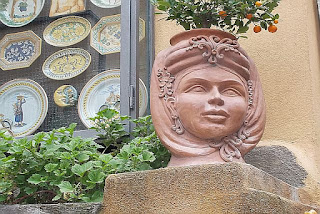 |
| Les Ilets de la Plage is a little bit of heaven in paradise (Les Ilets de la Plage) |
ST. BARTHS -- One of the best things about travel is
finding a special rate that allows you to live like royalty. St. Barths has
long been an oasis of solitude for luxury travel, making it a popular
destination for celebrities and jet setters from around the world.
So here's a
little secret for sunworshippers who thought St. Barths was beyond their
budget. Les Ilets de la Plage is offering a three-night summer package from now
until July 10, 2017 for a two bedroom Garden Villa for $255 per person based on
occupancy of four, or $300 per person for a one bedroom garden villa.
 |
| Lush St Barts (Taylor) |
Rates
increase on July 11 until August 31, but they are still a bargain when compared
to other elegant properties.
Among the
best features of Les Ilets de la Plage is the privacy of this family owned and
operated property with its stunning views of the best known and most popular
beach on St. Barths, St. Jean Bay. Not far away is St. Barths north shore with
its array of trendy bistros and boutiques.
 |
| St. Jean Beach is the most popular spot on the island (Taylor) |
Les Ilets
de la Plage is a tiny, understated resort featuring 11 villas on St. Jean Beach. The four one-bedroom
beachfront duplex villas feature covered terraces which open to a grassy area
that spills into the sand and surf.
There are also seven hillside villas built on the slope from the beach
in traditional Caribbean ranch style surrounded by gardens filled with tropical
flowers and palm trees. Each villa has a view of the gardens or St. Jean Beach.
 |
| St, Barths harbor (Taylor) |
Accommodations
are simply, but elegantly appointed with fully equipped kitchens, air
conditioned bedrooms, sitting area, Wi-Fi, satellite television and en-suite
bathrooms. A concierge is on-duty throughout the day to assist guests with
other services such as rental cars, restaurant reservations, babysitting, boat
charters and the like.
Best of all
the three night package for a one bedroom is based upon double occupancy with a
third person staying for free. Amenities include croissants, pastries and a
morning newspaper delivered to the door plus a bottle of Rose.
 |
| Livin' is easy on St Barts (Taylor) |
Food can be
expensive on this hilly jewel that nestles about 22 miles southeast of St.
Martin, so to further reduce costs you may want to budget by shopping at local
stores and taking advantage of the kitchen in the villa.
For getting
around, a rental car is probably the best way to see everything, however, if
beach life is your cup of tea then
Les
Ilets de la Plage will more than satisfy your needs as the perpetual Caribbean
sunshine makes its way across the cerulean sky.
Gustavia
Harbor is a focal point of activity on St. Barths with plenty of shopping,
quaint boutiques, eclectic cuisine and a bit of history to boot. Surrounded by
shallow reefs, the area of St. Barths is just under 10 square miles. It is the
only island in the Caribbean that is of Swedish origin, and the Three Crowns of
the Swedish national arms still appear in the island's coat of arms.
 |
| Tucked beneath the palms on St Jean Beach (Les Ilets de la Plage) |
Christopher
Columbus was the first European to visit the island in 1493, naming it after
his brother Bartolomeo. During the next century the island began to take shape
under formal colonization.
St.
Barths became French in 1946 with electricity coming to most of the island 15
years later in 1961. Electricity proved to be the turning point as hotels and
tourism sprang up almost overnight.
In
the early 1990s St. Barths boasted of two cooking schools: the St. Barts
Cooking School emphasizing classical French cuisine and Cooking in Paradise
which focused on creole dishes. Even today, food is one of the primary
attractions to St. Barths with more than 70 restaurants of which a significant
number offer gourmet specialties.
You
will also find "snacks" which the French call "les snacks"
or "les petits creux" that include sandwiches, pizza and salads. Even
so, compared to other places in the world, "les snacks" can be
pricey.
No
matter. Just think of the money you saved at Les Ilets de la Plage, lay out in
the sun and then splurge for one night out on the town and you have the makings
of an ideal mini-vacation.
 |
| Landing on St Barths is a thrill ride (Taylor) |
 |
| St Barts Beach is pristine (Taylor) |
























